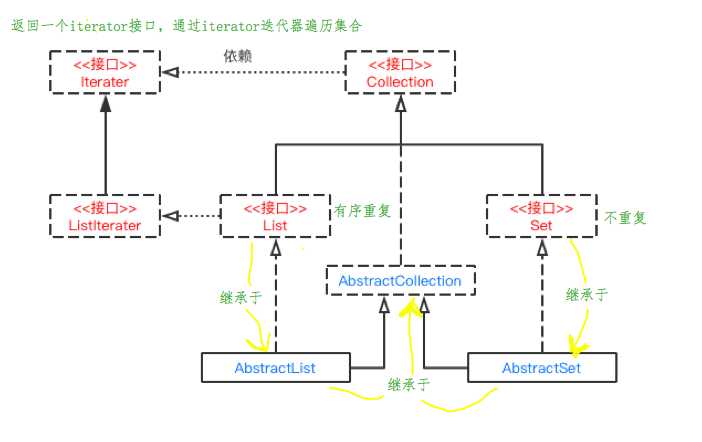标签:自己 一个 except java png nal ack 必须 保护
Collection的一些框架类的关系图:

1 Collection简介
Collection的定义
public interface Collection<E> extends Iterable<E> {}
它是一个接口,是高度抽象出来的集合,它包含了集合的基本操作:添加、删除、清空、遍历(读取)、是否为空、获取大小、是否保护某元素等等。
Collection接口的所有子类(直接子类和间接子类)都必须实现2种构造函数:不带参数的构造函数 和 参数为Collection的构造函数。带参数的构造函数,可以用来转换Collection的类型。
// Collection的API abstract boolean add(E object) abstract boolean addAll(Collection<? extends E> collection) abstract void clear() abstract boolean contains(Object object) abstract boolean containsAll(Collection<?> collection) abstract boolean equals(Object object) abstract int hashCode() abstract boolean isEmpty() abstract Iterator<E> iterator() abstract boolean remove(Object object) abstract boolean removeAll(Collection<?> collection) abstract boolean retainAll(Collection<?> collection) abstract int size() abstract <T> T[] toArray(T[] array) abstract Object[] toArray()
2 List简介
list的定义如下
public interface List<E> extends Collection<E> {}
List是一个继承于Collection的接口,即List是集合中的一种。List是有序的队列,List中的每一个元素都有一个索引;第一个元素的索引值是0,往后的元素的索引值依次+1。和Set不同,List中允许有重复的元素。
关于API方面。既然List是继承于Collection接口,它自然就包含了Collection中的全部函数接口;由于List是有序队列,它也额外的有自己的API接口。主要有“添加、删除、获取、修改指定位置的元素”、“获取List中的子队列”等。
// Collection的API abstract boolean add(E object) abstract boolean addAll(Collection<? extends E> collection) abstract void clear() abstract boolean contains(Object object) abstract boolean containsAll(Collection<?> collection) abstract boolean equals(Object object) abstract int hashCode() abstract boolean isEmpty() abstract Iterator<E> iterator() abstract boolean remove(Object object) abstract boolean removeAll(Collection<?> collection) abstract boolean retainAll(Collection<?> collection) abstract int size() abstract <T> T[] toArray(T[] array) abstract Object[] toArray() // 相比与Collection,List新增的API: abstract void add(int location, E object) abstract boolean addAll(int location, Collection<? extends E> collection) abstract E get(int location) abstract int indexOf(Object object) abstract int lastIndexOf(Object object) abstract ListIterator<E> listIterator(int location) abstract ListIterator<E> listIterator() abstract E remove(int location) abstract E set(int location, E object) abstract List<E> subList(int start, int end)
3 Set简介
set的定义
public interface Set<E> extends Collection<E> {}
Set是一个继承于Collection的接口,即Set也是集合中的一种。Set是没有重复元素的集合。
关于API方面。Set的API和Collection完全一样。
// Set的API abstract boolean add(E object) abstract boolean addAll(Collection<? extends E> collection) abstract void clear() abstract boolean contains(Object object) abstract boolean containsAll(Collection<?> collection) abstract boolean equals(Object object) abstract int hashCode() abstract boolean isEmpty() abstract Iterator<E> iterator() abstract boolean remove(Object object) abstract boolean removeAll(Collection<?> collection) abstract boolean retainAll(Collection<?> collection) abstract int size() abstract <T> T[] toArray(T[] array) abstract Object[] toArray()
4 AbstractCollection
定义如下:
public abstract class AbstractCollection<E> implements Collection<E> {}
AbstractCollection是一个抽象类,它实现了Collection中除iterator()和size()之外的函数。
AbstractCollection的主要作用:它实现了Collection接口中的大部分函数。从而方便其它类实现Collection,比如ArrayList、LinkedList等,它们这些类想要实现Collection接口,通过继承AbstractCollection就已经实现了大部分的接口了。
5 AbstractList
定义如下:
public abstract class AbstractList<E> extends AbstractCollection<E> implements List<E> {}
AbstractList是一个继承于AbstractCollection,并且实现List接口的抽象类。它实现了List中除size()、get(int location)之外的函数。
AbstractList的主要作用:它实现了List接口中的大部分函数。从而方便其它类继承List。
另外,和AbstractCollection相比,AbstractList抽象类中,实现了iterator()接口。
6 AbstractSet
定义如下:
public abstract class AbstractSet<E> extends AbstractCollection<E> implements Set<E> {}
AbstractSet是一个继承于AbstractCollection,并且实现Set接口的抽象类。由于Set接口和Collection接口中的API完全一样,Set也就没有自己单独的API。和AbstractCollection一样,它实现了List中除iterator()和size()之外的函数。
AbstractSet的主要作用:它实现了Set接口中的大部分函数。从而方便其它类实现Set接口。
7 Iterator
定义如下:
public interface Iterator<E> {}
Iterator是一个接口,它是集合的迭代器。集合可以通过Iterator去遍历集合中的元素。Iterator提供的API接口,包括:是否存在下一个元素、获取下一个元素、删除当前元素。
注意:Iterator遍历Collection时,是fail-fast机制的。即,当某一个线程A通过iterator去遍历某集合的过程中,若该集合的内容被其他线程所改变了;那么线程A访问集合时,就会抛出ConcurrentModificationException异常,产生fail-fast事件。关于fail-fast的详细内容,我们会在后面专门进行说明。TODO
// Iterator的API abstract boolean hasNext() abstract E next() abstract void remove()
8 ListIterator
定义:
public interface ListIterator<E> extends Iterator<E> {}
ListIterator是一个继承于Iterator的接口,它是队列迭代器。专门用于便利List,能提供向前/向后遍历。相比于Iterator,它新增了添加、是否存在上一个元素、获取上一个元素等等API接口。
// ListIterator的API // 继承于Iterator的接口 abstract boolean hasNext() abstract E next() abstract void remove() // 新增API接口 abstract void add(E object) abstract boolean hasPrevious() abstract int nextIndex() abstract E previous() abstract int previousIndex() abstract void set(E object)
本文来自http://www.cnblogs.com/skywang12345/p/3308513.html
标签:自己 一个 except java png nal ack 必须 保护
原文地址:https://www.cnblogs.com/msymm/p/9871968.html